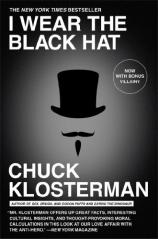I Wear the Black Hat: Grappling with Villains (Real and Imagined)
Review
I Wear the Black Hat: Grappling with Villains (Real and Imagined)
For the past several years, I have enjoyed attending the Tucson Festival of Books, an annual gathering of authors and readers held on the campus of the University of Arizona during spring break. It is an incredible weekend for discussing books, writing and related topics. For avid readers it is Christmas in March. This past festival introduced me to Chuck Klosterman, an author I recognized by name but whose books I had never experienced. He read excerpts from his newest effort, I WEAR THE BLACK HAT, and I immediately knew I wanted to read it. I was not disappointed.
Klosterman has produced a thoughtful and provocative discussion on good and evil in our society. He has written the type of book that I want to encourage my friends to read so we can discuss some of the conundrums he has raised. While I do not belong to book groups, I would join one that was reading I WEAR THE BLACK HAT.
Klosterman is a modern-day Renaissance man, essayist and critic of American culture. He has written seven books and magazine articles for publications as diverse as GQ, Esquire, The Onion and The Guardian, as well as writing about sports and popular culture for ESPN. He currently serves as “The Ethicist” for theNew York Times Magazine. His writing is equal parts self-interrogation, imagination, humor and poignancy that is wonderfully readable.
"I WEAR THE BLACK HAT is a thoughtful and provocative discussion of the often knee-jerk method of looking at good and evil. American culture and morality have been placed under a microscope for a brief view by a thoughtful writer. All of us can benefit from considering Klosterman's insights on this question."
I WEAR THE BLACK HAT provocatively questions who really are the bad guys and why some are embraced by society while others are shunned. Why, for example, does our culture revere a fictional crime fighter such as Batman while shunning a man like Bernhard Goetz. Clearly one man exists only in our mind, and one actually responded in real life to a crime he observed. But the real question becomes “Why are actions unacceptable in life somehow acceptable in fiction?” Klosterman suggests it is because fiction is the only vehicle that allows us to comfortably examine the morally obscene. In real life, our culture understands that violent responses to crime make society worse. In a book or a movie, the vigilante cares about us. In real life, the vigilante is a far more complicated and complex individual.
Klosterman’s discussions focus more on contemporary villians rather than historical figures (with an exception discussed later). But a major theme is the fine line between who is a villain and who is a charismatic figure. People who hijack airplanes are villians unless they are a charismatic mysterious legend like D.B. Cooper. Multiple drug offenders are villains unless they perform for The Rolling Stones and can do a benefit concert for the blind. Two of television’s best shows of the past decade, “The Wire” and “Breaking Bad,” are built on the moral ambiguity of men who sold heroin and methamphetamine. President Obama called Omar Little, a paid hit man on “The Wire,”one of his favorite characters. Not many politicians would express admiration for a man who killed dozens of people with a shotgun. Clearly a villain is defined by motive, but motive has many nuances, which often draw the line between the beloved hero and the despised villain.
While Klosterman dwells in the present for the major portion of I WEAR THE BLACK HAT, he almost apologetically devotes his final chapter to a discussion of Adolf Hitler. When he described his project to a friend and advised that he did not intend to write about Hitler, he was told, “Then you are doing it wrong, Hitler is in the book.” In the end, Klosterman discovers that Hitler’s villainy defies definition. Actually, Hitler contradicts his thesis on villains. Villains, he concludes, are people who know the most and care the least. Hitler cared very much about many perverse things. He cared like crazy but did not know as much as he should have. In an ironic way, society has cheapened Hitler. Almost every political argument ends with someone being called a Nazi. Hitler’s imagined emotion has become the source of dozens of YouTube videos, in which a scene from a movie about Hitler is played with subtitles that make the Fuhrer upset over countless silly events. Klosterman’s discussion of the dictator ends on the obvious note that we do not need to criticize him in any new way. He is already the universal placeholder for evil.
I WEAR THE BLACK HAT is a thoughtful and provocative discussion of the often knee-jerk method of looking at good and evil. American culture and morality have been placed under a microscope for a brief view by a thoughtful writer. All of us can benefit from considering Klosterman's insights on this question.
Reviewed by Stuart Shiffman on July 12, 2013
I Wear the Black Hat: Grappling with Villains (Real and Imagined)
- Publication Date: July 1, 2014
- Genres: Essays, Nonfiction, Popular Culture
- Paperback: 256 pages
- Publisher: Scribner
- ISBN-10: 143918450X
- ISBN-13: 9781439184509





